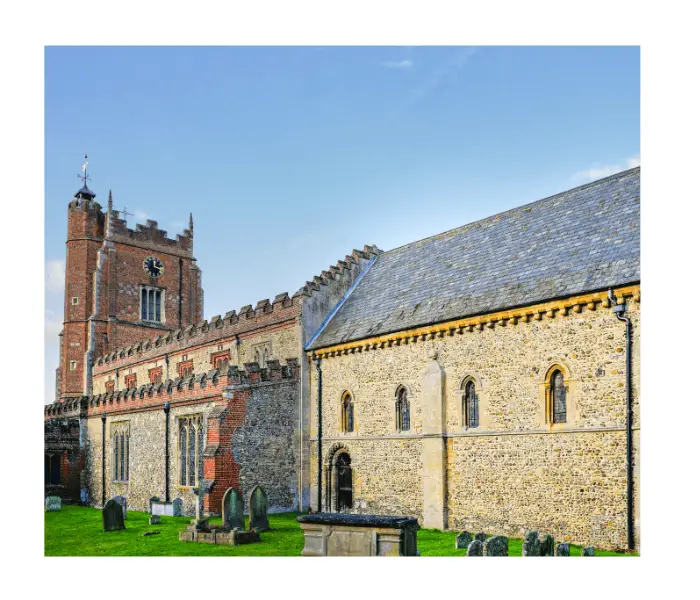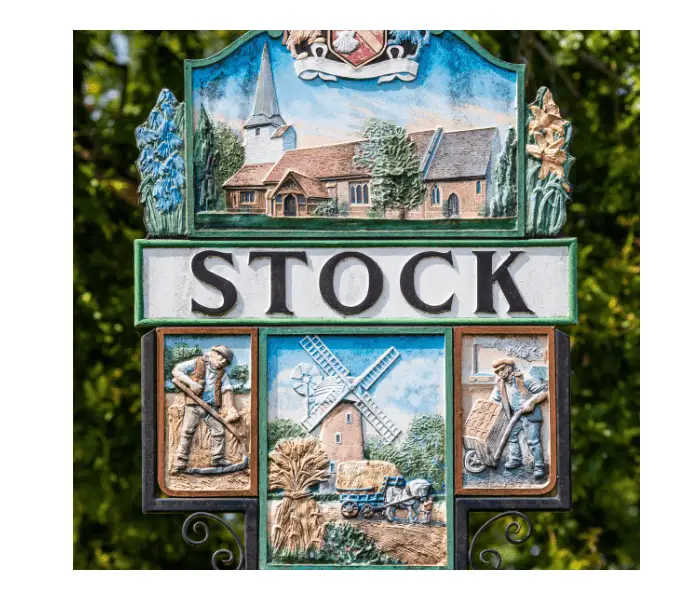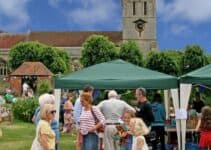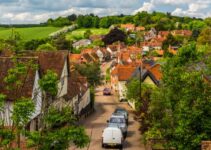Despite Essex’s perception in popular culture, there’s a lot more to it under the surface. In fact, some of the prettiest villages in Essex remain hidden gems to all apart from those who live in them.
Essex has a long and fairly English history. It was founded in the 6th century by Anglo Saxons, but of course it was populated long before then.
Thanks to its roughly 2000 years of recorded history, it has some interesting place names deriving from Latin and Old English.
So, let’s take a look at the top 10 prettiest villages in Essex. As part of this, we’ll mention some great coast villages, too, and check out the biggest village in the county.
Hopefully, it’ll be more than enough to inspire you to take a deeper tour of one of England’s central home counties.
10 of the Prettiest Villages in Essex
This list of the prettiest villages in Essex is in no particular order. You’ll definitely find something that’ll appeal to any taste, whether you want history, culture, a great walking destination, or simply a good pub to drink at!

1. Wendens Ambo
Let’s start with an Essex village with an interesting name: Wendens Ambo. The history of its name, unfortunately, isn’t as interesting as you might think.
It was originally 2 settlements: Wendens Magna and Wenden Prava, meaning “great” and “little”, respectively. They were merged in the 17th century into Wenden Ambo. Ambo is Latin for “both”.
Although the village dates back to the pre-Roman period, most of its buildings are from the 17th-19th centuries.
But if you’re a history-chaser, this is more than enough to enjoy. The cottages give off the perfect old English village vibe you’re probably looking for.
2. Ashdon
Not too far away is the village of Ashdon, built on the River Bourn. With a population of around 900, it’s still a pretty small and quaint village.
It has a long history as a farming community, and was also the site of an important battle in 1016. It’s believed that it was even home to a vineyard in the 19th century.
The village is home to one of the last remaining windmills in the county, which you can learn all about in the local museum.
There’s also an Iron Age burial site about 2 miles away from the village, so it’s a great pick for history buffs.
While there are plenty of beautiful historic buildings, there has been some serious flooding in recent years. The buildings are still standing, but don’t be surprised if you see some flood defences that might ruin the historic illusion.
3. Castle Hedingham
It’s probably no surprise what this village is famous for. Castle Hedingham is a small village in northern Essex that, shockingly, is home to a Norman castle.
The castle was built in the 11th century and the town grew around it thanks to the local market.
Unlike the other villages mentioned so far, it’s kept much of its original heritage. There’s a 12th-century church, a 13th-century hospital, and plenty of timber framed buildings.
The castle is privately owned but it regularly holds public events. Failing that, there are plenty of other amazing sites to see in this quaint and ancient village.

4. Stock
Stock is a village near Chelmsford, which is Essex’s county town. By village standard, it’s fairly large – it has a population of 2,100.
Although its origins are debated, there is a medieval windmill on the outskirts of the town. There are also 3 medieval churches that are worth checking out.
Perhaps more importantly, there are 3 pubs in the village’s centre, which focus on old-school character and local ales. The oldest of the 3, The Hoop, was built in 1460.
It hosts a beer festival in May that celebrates local ales, so it’s definitely worth checking out if that’s your thing.

5. Tolleshunt D’Arcy
Tolleshunt D’Arcy is about as English in name and appearance as you can really get. Tolleshunt comes from the Anglo Saxon for “Toll’s Spring” and the D’Arcy relates to the history of the manor’s lords.
Throughout the Middle Ages, it was known as Tolleshunt Tregoz, Tolleshunt Valoines, and Tolleshunt de Boys.
The name changed every time a female heir married and took their husbands’ names. It became Tolleshunt D’Arcy when a de Boys woman married John D’Arcy, and the name stuck.
The village is the origin of the D’Arcy Spice apple, and the local pub – the Queen’s Head, is on the National Inventory of Historic Pub Interiors.
It was also home to famed crime detective novelist, Margery Allingham, whose old house has a blue plaque in her honour. And, if things weren’t English enough, the village is home to a permanent Maypole, one of the last genuine ones in the country.
6. Wrabness
Next up with an unusual name is Wrabness. Its origin is as unsurprising as Wendens Ambo’s. It comes from the Anglo Saxon name, Wrab, and the Old English word for headland.
It’s built on the mouth of the Stour Estuary, hence the headland part of its name.
The oldest building in the village is the church, which dates from around 1100. The original wooden bell cage is still in the churchyard, where it was located after it fell down in the 17th century.
There are 2 other sites for completely different interests. The first is Wrabness Nature Reserve, located along the riverbanks.
It was originally a mine depot and is now home to some rare wildlife, including owls and nightingales, and some interesting plant life.
The other is Julie House, a holiday home designed by artist Grayson Perry. It’s a concept building dedicated to women and the landscape of Essex.
If you know anything about Perry’s work, you’ll know exactly what to expect.
7. Tillingham
Tillingham is part of something called the Dengie Hundred, which is an ancient administrative district used in England and Wales.
As you can imagine, villages within a boundary like this are pretty traditional in appearance and character, and Tillingham is no exception.
The village has 2 claims to fame, one of which is much nicer than the other. It was a favourite of author H.G. Wells, who mentions it in his novel, The War of the Worlds.
It’s where the narrator’s brother flees after the Martian invasion.
The second is far darker. A 17th-century pamphlet called ‘The Ranter’s Monster’ describes how a local girl, Mary Adams, thought she was the Virgin Mary.
Believing she was mad, the local vicar imprisoned her, during which time she gave birth. The baby was apparently a “monster”, apparently a punishment from God.
Despite this horrible story, the village itself is lovely. It’s surrounded by marshland, so is ideal for walkers who can finish their day out with a drink at one of the two local pubs.
8. Feslted
Also written as Felstead, this is a small village almost in the middle of Essex. It’s mentioned in the Domesday Book, but this likely means that its history goes back much further.
It’s surrounded by numerous small hamlets that fall under its civil parish district.
It has a traditional English village high street that’s home to pubs, an antique shop, and a few boutiques. Although you probably won’t visit Felsted to go shopping, it completes the sort of vibe you’d expect from a place like this.
The village is home to an independent school, Felsted School, which dates back to the 16th century. It’s where Oliver Cromwell sent his sons to be educated, something the school is still very proud of.
9. Finchingfield
Finchingfield is called “the most photographed village in England”. Granted, it gets this title from Essex’s tourism board, but it should illustrate how picturesque it really is. The centre of the village is quite beautiful, even by the strictest standards.
It has a village green and duck pond that are surrounded by old buildings and a medieval church and windmill. Finchingfield has even won awards for its appearance.
Other than looking around at the beautiful buildings, there’s not much to do. However, that doesn’t really matter because simply visiting the village is enough of an experience.
It was home to Dodie Smith, the author of The Hundred and One Dalmatians, whose grave you can visit. It’s currently home to Jamie Oliver, who filmed some of his earlier TV series in and around the village.
10. Coggeshall
Calling Coggeshall a village is a bit tenuous, as it was a medieval market town, and still technically is a town. However, it won Best Kept Village in Essex in 1998 and from 2001-2003. It also won Village of the Year in 2003 and is listed as “Village of the Year” on its road signs.
So, for the purpose of this list, it’s fair to call it one of the prettiest villages in Essex. In fact, thanks to the numerous awards, it might be the prettiest village in the county.
There’s probably not much that needs saying about the village’s appearance, as the awards speak for themselves. It’s home to plenty of old buildings, including a pub that’s been running since the 1550s (The Chapel Inn).
The village has held a market every week since the 13th century, hence why it’s officially considered a market town.
With a bit of poking around, you can find evidence of much earlier settlement. There are still visible Roman aqueducts and old buildings relating to the medieval monastery.
So whether you’re into history or just want to visit an archetypal English village, Coggeshall might be the place for you.
What is the Biggest Village in Essex?
The title of biggest village is debatable because it depends on how you define big. In terms of settlements, it can either mean geographic area or population.
However, the more accurate measurement is probably population, as villages are typically defined as small rural settlements with a population of between 500 and 2,500.
So, what is the biggest village in Essex?
The answer is probably Tiptree, located roughly 10 miles from Colchester. In the 2011 census, it had a listed population of around 9,100.
Due to rapid recent development, the population is probably much higher now. So, by the normal definition of a village, it’s well beyond the population size.
But it has a specific claim to still being a village. In 1999, the local council held a referendum to upgrade Tiptree to town status.
It was almost unanimously rejected by the local population, meaning Tiptree is still officially a village despite its size. In fact, this puts it on the list of largest villages in England.
Another top contender is Great Baddow. Its population is over 13,000, making it one of the largest villages in the UK.
However, it’s what’s known as an urban village because it’s been almost entirely subsumed into Chelmsford. As such, it doesn’t quite fit the village definition in the same way Tiptree does.
It’s still a distinct area from Chelmsford. But the boundary lines between the two settlements don’t really exist anymore, so it’s commonly regarded as part of the larger Chelmsford borough.
Deciding on the biggest village in Essex largely depends on your definition of a village, and of the term “big”. Technically, Tiptree fulfils it because it’s more rural and officially rejected the title of town.
Great Baddow similarly was never turned into a town, but its proximity to Chelmsford makes it more difficult to define as a village using any of the standard criteria.
Best Coastal Villages in Essex
Two of the villages mentioned in the top 10 list above are coastal villages. Wrabness and Tillingham are both on the coast, but they deserve a spot in the prettiest villages in Essex.
But that’s not to say that the villages below aren’t pretty. However, they deserve separate mentions because much of their appeal is tied up in their proximity to the coast. So, let’s look at some of the best coastal villages in Essex.
1. Rowhedge
Rowhedge is situated on the coast of the River Colne. Although not completely on the sea coast, Colne is a tidal river, meaning the village still experiences tidal shifts.
It’s the first settlement downstream from Colchester and its history is intimately tied to its location.
Like other coastal villages, it was a central location for the transportation of goods further inland. It was also home to a shipbuilding yard and was a busy village port during the Victorian era.
In the 20th century, Rowhedge was important for the war efforts; it transported soldiers and also helped build ships used on D-Day.
It’s a quaint little village that’s perfect for walking around on a summer afternoon. There are 2 pubs and plenty of places to get coffee.
You can also have a look around the old shipbuilding yard and watch the annual raft race, which takes place in the summer.
2. Fingeringhoe
Fingeringhoe is located on the bank of the Roman River, which is just slightly south of Rowhedge. Unsurprisingly, the village frequently appears on lists of unusual place names.
Despite its potentially rude implications, its name’s history is actually quite mundane. It sits on a hoe, which is a piece of land that juts out. The piece of land is shaped like a finger, hence Fingeringhoe.
Its recorded history goes back to Roman Britain, where it was used as a port for the nearby settlement of Camulodunum, which is Colchester.
It’s likely that the village’s history goes back much further, as it’s almost perfectly located for a port village.
The village centre is a protected heritage site. It features a village pond and red phone box, which are covered under conservation status. As you can imagine, the surrounding buildings lend to this traditional charm, meaning it ticks every box you could want from an Essex village.
Among its minor claims to fame is a reference in Karl Marx’s Das Kapital. He uses it as an example of capitalist accumulation in action, which is interesting considering its lack of any notable industry.
Fingeringhoe is surrounded by salt marshes, which are contained within Fingeringhoe Wick Nature Reserve. As such, it’s a great choice for walkers who want to see some good local wildlife.
3. Tollesbury
Tollesbury was always an agricultural village, but it was different from others because it embraced both land- and water-based harvests.
This is evident on its village sign, which features a plough on one side and a sail on the other. It’s still famous for its oyster harvests, which come from the coast around the mouth of the River Blackwater.
The village retains some interesting historical elements. Many of its cottages were built using local bricks, and its surviving pub was specifically for sailors.
It also has something called a lock-up building, which is a small wooden shack where drunks were kept while they sobered up. You can find it in the south-east corner of the village square.
Its historic charm has led to Tollesbury being a popular filming location for period dramas. It served as the location for the BBC adaptation of Great Expectations along with the ITV drama, Liars.
4. Maylandsea
Maylandsea and Mayland are two separate villages, but they’re typically discussed together because of their close proximity and similar names. They’re located in the Dengie Hundreds in the Maldon district.
Maldon would ideally have a place on this list because of its internationally-renowned salt trade, but it’s unfortunately a town.
However, if you’re in the area visiting coastal villages, make sure you stop by Maldon. Its sea salt is a favourite of Nigella Lawson, among many others.
Mayland’s history is very similar to other coastal Essex villages. The boatyard serviced larger inland settlements and had a big role during WW2.
The village centre is home to an award-winning Indian restaurant, Zara.
One of the biggest draws of Mayland that other villages don’t have is its large number of fossils. You’re allowed to go hunting for fossils along the coast near the village, but just be careful the tide doesn’t catch you.
There’s also a crashed WW2 plane in a nearby creek that you can see at low tide.
5. Jaywick
Jaywick is a small village within walking distance of Clacton-on-Sea. While it lacks the same kind of amenities as its bigger neighbour, this is arguably part of its charm.
You get the same kind of beach (it’s only 2 miles away, after all), just without all the tourists.
It’s a comparatively new village compared to the other entries on this list. Jaywick was purpose-built in 1928 as a holiday destination for people from London. Before then, it was an almost uninhabited marshland that was used for hunting.
When developer Frank Stedman began building Jaywick, he saw it as a wellness holiday retreat. For almost no reason, he designed the village in the shape of a car’s radiator and named the roads after car manufacturers.
Over the next decade, it slowly declined in popularity as a holiday destination.
After WW2, many of the properties became permanent homes, even though they were only designed for holidays. Plenty of these buildings still stand, as they were put under special planning permission laws.
So, although Jaywick perhaps doesn’t have the same kind of traditional English charm as other entries on this list, a large part of its appeal comes from it being essentially stuck in a different time period. If you’ve ever been interested in what a 20th-century holiday village looks like, this is the spot for you.
Final Thoughts on the Prettiest Villages in Essex
There we have it, a roundup of some of the best villages in Essex. Whether you’re looking for quaint English charm, proper seaside appeal, or a combination of the two, Essex villages will have you covered.
Of course, this list by no means covers all the things worth seeing in Essex. In fact, the towns and cities are definitely worth seeing, too, but they’re more widely known. So, use this list as a starting point and get exploring the county of Essex!



